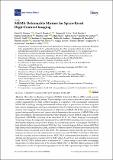MEMS Deformable Mirrors for Space-Based High-Contrast Imaging
Author(s)
Morgan, Rachel E.; Douglas, Ewan S.; Allan, Gregory W.; Bierden, Paul; Chakrabarti, Supriya; Cook, Timothy; Egan, Mark; Furesz, Gabor; Gubner, Jennifer N.; Groff, Tyler D.; Haughwout, Christian Alexande; Holden, Bobby Glenn; Mendillo, Christopher B.; Ouellete, Mireille; do Vale Pereira, Paula; Stein, Abigail J.; Thibaultl, Simon; Wu, Xingtao; Xin, Yeyuan; Cahoy, Kerri; ... Show more Show less
DownloadPublished version (13.47Mb)
Terms of use
Metadata
Show full item recordAbstract
Micro-Electro-Mechanical Systems (MEMS) Deformable Mirrors (DMs) enable precise wavefront control for optical systems. This technology can be used to meet the extreme wavefront control requirements for high contrast imaging of exoplanets with coronagraph instruments. MEMS DM technology is being demonstrated and developed in preparation for future exoplanet high contrast imaging space telescopes, including theWide Field Infrared Survey Telescope (WFIRST) mission which supported the development of a 2040 actuator MEMS DM. In this paper, we discuss ground testing results and several projects which demonstrate the operation of MEMS DMs in the space environment. The missions include the Planet Imaging Concept Testbed Using a Recoverable Experiment (PICTURE) sounding rocket (launched 2011), the Planet Imaging Coronagraphic Technology Using a Reconfigurable Experimental Base (PICTURE-B) sounding rocket (launched 2015), the Planetary Imaging Concept Testbed Using a Recoverable Experiment - Coronagraph (PICTURE-C) high altitude balloon (expected launch 2019), the High Contrast Imaging Balloon System (HiCIBaS) high altitude balloon (launched 2018), and the Deformable Mirror Demonstration Mission (DeMi) CubeSat mission (expected launch late 2019). We summarize results from the previously flown missions and objectives for the missions that are next on the pad. PICTURE had technical difficulties with the sounding rocket telemetry system. PICTURE-B demonstrated functionality at > 100 km altitude after the payload experienced 12-g RMS (Vehicle Level 2) test and sounding rocket launch loads. The PICTURE-C balloon aims to demonstrate 10-7 contrast using a vector vortex coronagraph, image plane wavefront sensor, and a 952 actuator MEMS DM. The HiClBaS flight experienced a DM cabling issue, but the 37-segment hexagonal piston-tip-tilt DM is operational post-flight. The DeMi mission aims to demonstrate wavefront control to a precision of less than 100 nm RMS in space with a 140 actuator MEMS DM.
Date issued
2019-05Department
Massachusetts Institute of Technology. Department of Aeronautics and Astronautics; Massachusetts Institute of Technology. Department of Earth, Atmospheric, and Planetary SciencesJournal
Micromachines
Publisher
MDPI AG
Citation
Morgan, Rachel E., et al. “MEMS Deformable Mirrors for Space-Based High-Contrast Imaging.” Micromachines 10, 6 (May 2019): 366. © 2019 The Authors
Version: Final published version
ISSN
2072-666X